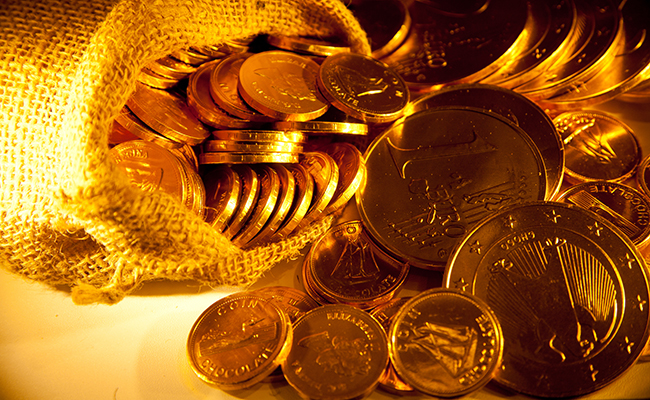
'Gold schemes to cut down imports, bridge trade deficit'
 Welcoming the launch of the three gold schemes, industry leaders on Friday said the move will help extract India's unutilised gold reserves, thus reducing the import bill and bringing down the current account deficit.
“Imports will come down significantly with these schemes. Reduction of imports will advantage treasury and the RBI as they will have less burden of US dollars. At least those investing in gold ETF (exchange traded fund) will try to switch over to investing in bonds because they are paying a nominal charge in the ETF. Here they are in fact going to earn. So the ETF portfolio may be switched over into bonds,” Ketan Shroff, spokesperson of the India Bullion and Jewellers Association Ltd. (IBJA), told The Dollar Business.
Prime Minister Narendra Modi on Thursday unveiled Gold Monetisation Scheme, Gold Sovereign Bond Scheme and Gold Coin and Bullion Scheme with an aim to mobilise about 20,000 tonnes of unused precious metal lying idle with households and religious institutions.
Under the Gold Monetisation Scheme, people can deposit their yellow metal and earn up to 2.5% interest, while the Sovereign Gold Bond scheme will enable investors to earn 2.75% interest per annum.
The government has, for the first time, unveiled India-minted national gold coin which has the National Emblem of Ashok Chakra carved on one side and Mahatma Gandhi on the other.
The coins are available in 5 grams, 10 grams and 20 grams denominations and will be sold through MMTC outlets.
India has long been dependent on gold imports for meeting its domestic requirements. The launch of these three schemes is expected to reduce imports and help bridge India’s current account deficient.
“India has about 20,000 tonnes of unused gold lying with the households and institutions. With the help of a monthly monitoring system, we will be able to deploy certain amount of gold in the market and reduce imports by a subsequent quantity. Gold available within the country should be put to a productive use, and these schemes show us the way to achieve this goal,” said Modi while announcing the schemes.
Imports of yellow metal have been on rise in the recent years. India imports 900-1000 tonnes of gold each year. During the first nine months of 2015, it has already imported more than 560 tonnes of gold.
“The past few years have witnessed an exponential increase in gold imports exerting tremendous pressure on our current account. These policies are steps in the right direction and would allow for channelisation of the unutilised domestic gold reserves towards supporting the country’s economic growth,” said A Didar Singh, Secretary General, FICCI.
Singh, however, suggested that the government should also establish a national gold board as it would ensure a smooth facilitation of gold transactions across the country.
“In order to make the schemes a success, creation of a strong infrastructure and standardization of price and quality will be essential. Also, establishment of a Gold Board would allow for better management of gold imports, encourage exports, facilitate infrastructure development and would ensure that India’s gold market functions effectively,” Singh said.
Welcoming the launch of the three gold schemes, industry leaders on Friday said the move will help extract India's unutilised gold reserves, thus reducing the import bill and bringing down the current account deficit.
“Imports will come down significantly with these schemes. Reduction of imports will advantage treasury and the RBI as they will have less burden of US dollars. At least those investing in gold ETF (exchange traded fund) will try to switch over to investing in bonds because they are paying a nominal charge in the ETF. Here they are in fact going to earn. So the ETF portfolio may be switched over into bonds,” Ketan Shroff, spokesperson of the India Bullion and Jewellers Association Ltd. (IBJA), told The Dollar Business.
Prime Minister Narendra Modi on Thursday unveiled Gold Monetisation Scheme, Gold Sovereign Bond Scheme and Gold Coin and Bullion Scheme with an aim to mobilise about 20,000 tonnes of unused precious metal lying idle with households and religious institutions.
Under the Gold Monetisation Scheme, people can deposit their yellow metal and earn up to 2.5% interest, while the Sovereign Gold Bond scheme will enable investors to earn 2.75% interest per annum.
The government has, for the first time, unveiled India-minted national gold coin which has the National Emblem of Ashok Chakra carved on one side and Mahatma Gandhi on the other.
The coins are available in 5 grams, 10 grams and 20 grams denominations and will be sold through MMTC outlets.
India has long been dependent on gold imports for meeting its domestic requirements. The launch of these three schemes is expected to reduce imports and help bridge India’s current account deficient.
“India has about 20,000 tonnes of unused gold lying with the households and institutions. With the help of a monthly monitoring system, we will be able to deploy certain amount of gold in the market and reduce imports by a subsequent quantity. Gold available within the country should be put to a productive use, and these schemes show us the way to achieve this goal,” said Modi while announcing the schemes.
Imports of yellow metal have been on rise in the recent years. India imports 900-1000 tonnes of gold each year. During the first nine months of 2015, it has already imported more than 560 tonnes of gold.
“The past few years have witnessed an exponential increase in gold imports exerting tremendous pressure on our current account. These policies are steps in the right direction and would allow for channelisation of the unutilised domestic gold reserves towards supporting the country’s economic growth,” said A Didar Singh, Secretary General, FICCI.
Singh, however, suggested that the government should also establish a national gold board as it would ensure a smooth facilitation of gold transactions across the country.
“In order to make the schemes a success, creation of a strong infrastructure and standardization of price and quality will be essential. Also, establishment of a Gold Board would allow for better management of gold imports, encourage exports, facilitate infrastructure development and would ensure that India’s gold market functions effectively,” Singh said.
November 06, 2015 | 4:28pm IST.






 to success.
to success.